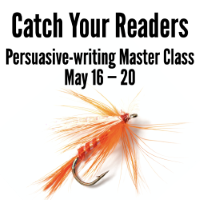Why accentuate the negative?
Fear appeals work.

That’s according to 100 studies and 50 years of research on fear appeals reviewed by researchers Kim Witte and Mike Allen.
Fear appeals — also known as scare tactics, shock tactics, negative messages, risk communications, threats and avoidance benefits — have a high “response efficacy,” researchers say.
In other words, a threat may be more likely to motivate behavior than a promise.
We’ve used fear appeals for decades.
Communicators and others have used fear appeals since antiquity to convince people to:
- Apply sunscreen
- Avoid drugs and alcohol
- Conduct breast self-exams
- Drive safely
- Duck and cover
- Eat plenty of fruits and vegetables
- Exercise
- Floss
- Learn self-defense techniques
- Not drink and drive
- Stop smoking
- Use condoms
- Wear seatbelts
You can use fear appeals in your persuasive messages, too, to get your readers to do everything from getting heart scans to buying long-term-care insurance to contributing to their retirement accounts.
Consequences more powerful than benefits.
Appeals can be positive: make money, save money, save time. But sometimes negative appeals work best.
In one extended parallel study, for instance, researchers tested two messages.
Negative:
By failing to perform breast self-examinations, you’ll be less likely to discover cancer in its early stages, so treatment will be less likely to work.
Positive:
By performing breast self-examinations, you’ll be more likely to detect breast cancer in its early stages, when it’s more treatable.
The negative version was nearly 20% more effective than the positive one at getting women to conduct breast self-exams.
So forget what your mother told you: If you can’t think of anything nice to say, say something negative. Your campaign may be more powerful.
How can you move people to act?
Your readers are bombarded with the data equivalent of 174 newspapers — ads included — every day, according to a study by USC’s Annenberg School for Communication.
 In this environment, how do you grab readers’ attention and move them to act?
In this environment, how do you grab readers’ attention and move them to act?
Learn how to think like a reader and use the bait your readers like at Catch Your Readers — our persuasive-writing workshop starting May 16.
You’ll learn to master a scientific, proven-in-the-lab system for getting people to pay attention to, understand, remember and act on your messages.
And you’ll take your message from “meh” to masterpiece with feedback from Ann Wylie and your colleagues.
Save upto $100 with our group discounts.
